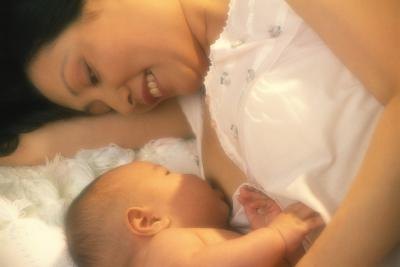
The majority of pediatric societies around the world, including the World Health Organization, the American Academy of Pediatrics and UNICEF, advocate exclusive breastfeeding for a baby's first 6 months. Health professionals recommend introducing solid foods between the age of 4 and 6 months, but whenever an infant shows signs of being ready for something other than breast milk is the best time.
When is a Baby Ready for Solids?
An infant who appears very interested in the food on his parents plates may be ready to try solids himself. By the age of 5 or 6 months, most infants are trying to grab their parents food and put it into their mouths. Other signs that breast milk may no longer be enough for him are that he is growing increasingly hungry and not gaining weight at an adequate rate. Only babies with good head control should be given solids.
How to Introduce Solids
Starting a baby on solids doesn't need to be a complicated process. A little solid food should be mashed with a fork and offered to her on a spoon. If she is under 6 months old, the food should be pureed. There's no need to worry about how much food she actually eats, according to the International Breastfeeding Centre. A lot of the food will end up in places other than her mouth, such as her hair, her face and the floor. The important thing is to be relaxed and let her enjoy sampling the food. If she is enjoying the food and still seems hungry, give her some more. There are no hard and fast rules when it comes to quantities; be led by your baby and her appetite.
Types of Food
It doesn't really matter what type of solid food an infant is offered. Its best to avoid very spicy foods, as well as foods to which he is more likely to be allergic, such as strawberries and egg whites. Apart from this, simply give him the food in which he is most interested. As he gets older and his taste buds mature, he will become a more accomplished eater and can be offered a wider range of foods. If he refuses to eat a particular type of food, such as fruit or vegetables, it's best not to force him. Waiting a few weeks and trying again is often successful, according to the International Breastfeeding Centre.
Breast Milk and Solids
The World Health Organization recommends continued breastfeeding until an infant is the age of 2 or older, supplemented by safe, appropriate, nutritious foods. The amount of milk a breastfeeding baby receives after starting on solids greatly depends on her age, weight and calorie intake, according to the award-winning pregnancy and parenting website BabyCenter. As a general guide, breastfeeding babies can be expected to nurse at least six times in a 24-hour period while on solid foods. It's important to have a relaxed approach and follow the infant's lead.
No comments:
Post a Comment